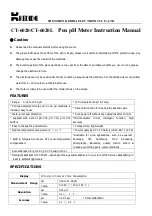
30119-02 Rev. 2.6/07-09
3
MAIN LINE METER
INSTALLATION
I. UNCRATING.
When uncrating the meter, any damage due
to rough or improper handling should be reported to the
transportation firm and McCrometer. If for any reason it
is determined that the unit or parts of the unit should be
returned to the factory, please contact McCrometer for
clearance prior to shipment. Each unit must be properly
crated to prevent any further damage. The factory assumes
no responsibility for equipment damage in return shipment
due to improper packaging. The shipping crate contains the
following items:
Main Line Meter Assembly with
Standard
Totalizer
............................................................1
Mounting Equipment as required ......................................-
Operation and Instruction Manual ....................................1
Tool
T-2402X-1
...............................................................1
II. INSTALLATION
of McCrometer Main Line Meters varies
depending upon the type and model of meter selected for
each application. The meter must have a full flow of liquid
for proper accuracy. The meter installations fall into three
basic categories:
1. FLANGED TUBE METERS
can be installed exactly as you
would install any short length of flanged pipe. Flanged ends
are standard pattern and drilling for any meter size.
2. PLAIN END TUBE METERS
can be installed similar to
replacing a short length of plain end pipe in the line by
either welding, or by using one of a variety of pipe couplings
available. NOTE: Meter head assembly (#13) should be
removed before welding. (See step IV.)
3. WELDING SADDLE METERS
can be installed on an exist-
ing pipeline by cutting a hole of proper size and welding a
meter saddle (furnished with the meter) to the pipe. The
installation steps outlined below should be followed carefully
to achieve proper mounting of the meter:
A. ALIGN
the cutout template in the desired position for the
meter on the pipe. Make certain that the center line of the
pipe and the center line marked on the template are parallel
with each other. Some people prefer to use the saddle as
the template.
B. SCRIBE
the pipe along the line specified for your meter size
cutout.
C. CUT OUT
the section of pipe within the scribed line and
remove all burrs, slag, and rough edges from the inside and
outside of the cutout section.
D. STRAIGHTENING VANES
are recommended when there
is less than ten pipe diameters of straight pipe (no fittings
or obstructions) directly upstream from the meter location.
Straightening vanes are available from the factory and when
required should be installed in the following manner, prior
to welding the saddle to the pipe:
a.) HOLD
the vanes on the outside of the pipe ten
MAIN LINE METER
INDEX
I.
UNCRATING
II. INSTALLATION
1.
Flanged Tube Meters
2.
Plain End Tube Meters
3.
Welding Saddle Meters
A.
Align
B.
Scribe
C.
Cut Out
D.
Straightening Vanes
a.)
Hold
b.)
Mark
c.)
Insert
E.
Welding Saddle
F.
Meter Assembly
III. METER SERVICE SCHEDULE
IV. METER HEAD ASSEMBLY
V. WORKING
AREA
VI. TOTALIZER
ASSEMBLY
1.
Bonnet Mounting Screws
2.
Totalizer
3.
Totalizer Change Gears
4.
Totalizer Drive Magnet
VII. GEARBOX
VIII. VERTICAL SHAFT ASSEMBLY
IX. MITER GEAR FRAME ASSEMBLY
1.
Driven Miter Gear Assembly
2.
Drive Miter Gear Assembly
3.
Components
X. PROPELLER
ASSEMBLY
1.
Propeller Removal
2.
Reverse Thrust Bearing Cartridge
3.
Water Lubrication
4.
Ceramic Bearing Cartridge
5.
Spindle Ceramic Sleeve
6.
Separator/Support Spindle Assembly
7.
Propeller Installation
8.
Thrust Bearing Cartridge Assembly
9.
Propeller Bearing
XI. INSPECTION
XII. REASSEMBLY
1.
Miter Gear Frame Assembly
2.
Gearbox
3.
Vertical Shaft Assembly
4.
Totalizer Drive Magnet Assembly
5.
Totalizer Base Cup
6.
Bonnet Assembly
7.
Propeller Assembly
8.
Meter Head Gasket






























